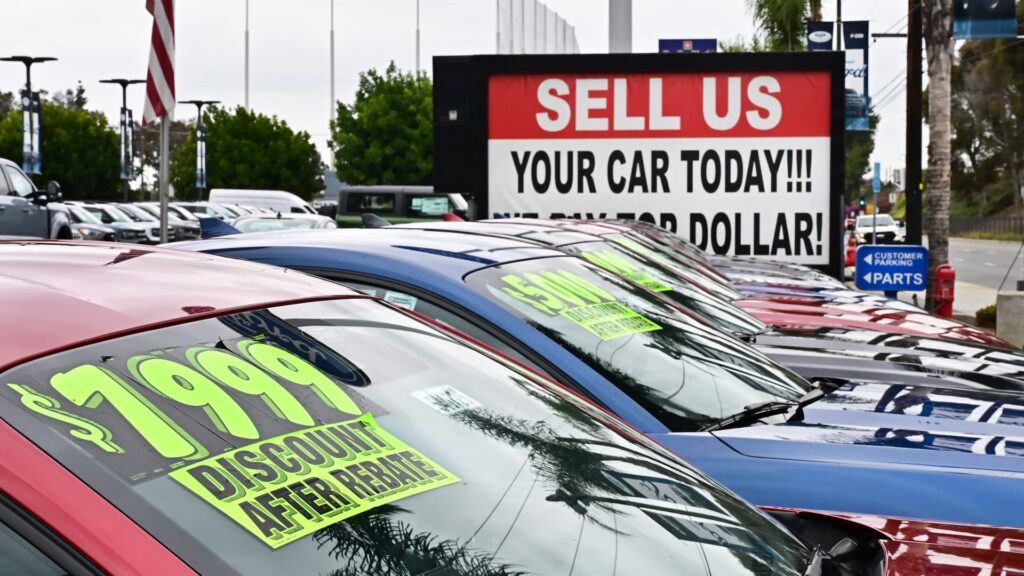
Used vehicle prices jump to highest level since 2023 amid auto tariffs
Used Vehicle Prices Surge to Highest Level Since 2023 as Auto Tariffs Trigger Market Concerns
Table of Contents
A Ford Mustang displayed at a used car dealership in Montebello, California on May 5, 2025. (Photo: Frederic J. Brown/AFP/Getty Images)
April’s Used Vehicle Price Surge
Used vehicle prices have climbed to their highest level since October 2023, according to the latest market data from Detroit. This surge comes as consumers accelerate purchases amid growing concerns over potential price increases resulting from recently implemented auto tariffs.
The closely monitored Manheim Used Vehicle Value Index, which tracks the pricing of used vehicles sold at wholesale auctions across the United States, registered a significant year-over-year increase of 4.9% in April, reaching a level of 208.2. This marks a considerable jump in used vehicle valuations and signals potential shifts in the broader automotive market.
The ‘spring bounce’ normally ends the second week of April, but this year, wholesale appreciation trends continued for the entire month and were much stronger than we typically observe. We expected to see strong price appreciation in response to the tariffs, and that’s exactly what came.
— Jeremy Robb, Senior Director of Economic and Industry Insights, Cox Automotive
Manheim Index Performance
The April data revealed not only a year-over-year increase but also a substantial month-over-month rise of 2.7% compared to March. According to Cox Automotive, the auto data and logistics firm that maintains the index, this represents a significant deviation from typical market patterns. A normal month-to-month movement in the index is approximately 0.2%, making April’s 2.7% increase more than 13 times the historical average.
Manheim Index Key Metrics: April 2025
While the current index reading of 208.2 remains below the record highs experienced during the height of the COVID-19 pandemic, it still represents an elevated level compared to historical pre-pandemic norms. This persistent elevation in used vehicle values continues to affect affordability for many American consumers who rely on the used vehicle market for transportation needs.
Auto Tariff Impact on the Market
The recent implementation of a 25% tariff on new imported vehicles and many automotive parts has created ripple effects throughout the automotive ecosystem. Although these tariffs do not directly target used vehicles, they significantly influence the dynamics of the used car market through their impact on new vehicle pricing, production decisions, and consumer demand patterns.
Market analysts point out that the interconnected nature of new and used vehicle markets means that policy changes affecting one segment inevitably influence the other. As new vehicle prices potentially increase due to tariff-related costs, many consumers are expected to shift their attention to the used market, driving up demand and consequently prices in that segment.
How Auto Tariffs Affect Used Vehicle Prices
- Shifted Demand: As new vehicle prices increase, more buyers turn to used options
- Supply Constraints: Production adjustments for new vehicles eventually reduce used vehicle supply
- Perceived Value: Higher-priced new vehicles make used vehicles seem like better values
- Dealer Strategy: Automotive retailers adjust their inventory mix and pricing in response to market shifts
- Consumer Psychology: Fear of future price increases accelerates purchase decisions
Consumer Purchasing Behavior
April’s market data suggests that consumers are actively responding to the changing automotive landscape by accelerating their purchasing decisions. This behavior appears to be driven primarily by concerns that prices will continue to rise as the full effects of the tariffs work their way through the supply chain and inventory cycles.
The Cox Automotive data indicates that despite the price increases, retail used-vehicle sales saw a significant year-over-year improvement of 13% in April. This growth occurred despite a slight month-over-month decline of 1.7% compared to March, suggesting that consumer demand remains relatively strong even in the face of rising prices.
Retail Price Trends
While wholesale prices as measured by the Manheim Index often serve as leading indicators for retail price movements, the relationship between wholesale and retail pricing has shown some interesting dynamics in recent years. Cox Automotive reports that retail prices have not fallen as quickly as wholesale prices during recent market adjustments.
Over the last four weeks, the average retail listing price for a used vehicle has increased by approximately 2%, pushing the average price beyond $25,000. This figure represents a significant premium compared to historical norms but remains substantially more affordable than the average new vehicle price, which currently hovers around $48,000.
Strategic Considerations for Used Vehicle Buyers
- Consider Acting Sooner: With prices trending upward, delaying purchases may result in higher costs
- Research Vehicle History: As prices increase, ensuring value through comprehensive vehicle history becomes more important
- Explore Alternative Models: Consider less-in-demand vehicle segments that may not see as significant price increases
- Factor in Total Cost of Ownership: Higher upfront costs may be offset by reliability and lower depreciation
- Monitor Market Trends: Stay informed about market developments to identify potential buying opportunities
Used Vehicle Market Outlook
Prior to the recent tariff implementation, Cox Automotive had observed a trend toward stabilization in used vehicle prices following several years of volatile price movements that began during the COVID-19 pandemic. The market had begun to calm down in 2024 after experiencing dramatic swings in both directions since 2020.
However, the latest data suggests that the tariff situation has introduced new variables that could potentially disrupt this stabilization process. Market analysts will be closely watching the coming months to determine whether April’s price increases represent a temporary reaction to policy changes or the beginning of a new trend in the used vehicle market.
While the Manheim index remains off the record highs it hit during the Covid pandemic, it is still relatively high compared to historic levels before the onset of the global health crisis in 2020.
As the automotive industry continues to navigate the complex landscape of tariffs, supply chain adjustments, and evolving consumer preferences, the used vehicle market will likely remain a crucial indicator of broader economic trends and consumer sentiment. For the majority of Americans who purchase vehicles through the used market, these developments will have direct implications for their transportation costs and purchasing power in the months ahead.
Consumers considering a vehicle purchase in the near future should remain attentive to market conditions and potentially adjust their timing and strategies to account for the current upward pressure on used vehicle prices. While future price movements remain subject to numerous variables including policy decisions, inventory levels, and consumer demand, the current trajectory suggests continued strength in used vehicle valuations at least in the short term.






